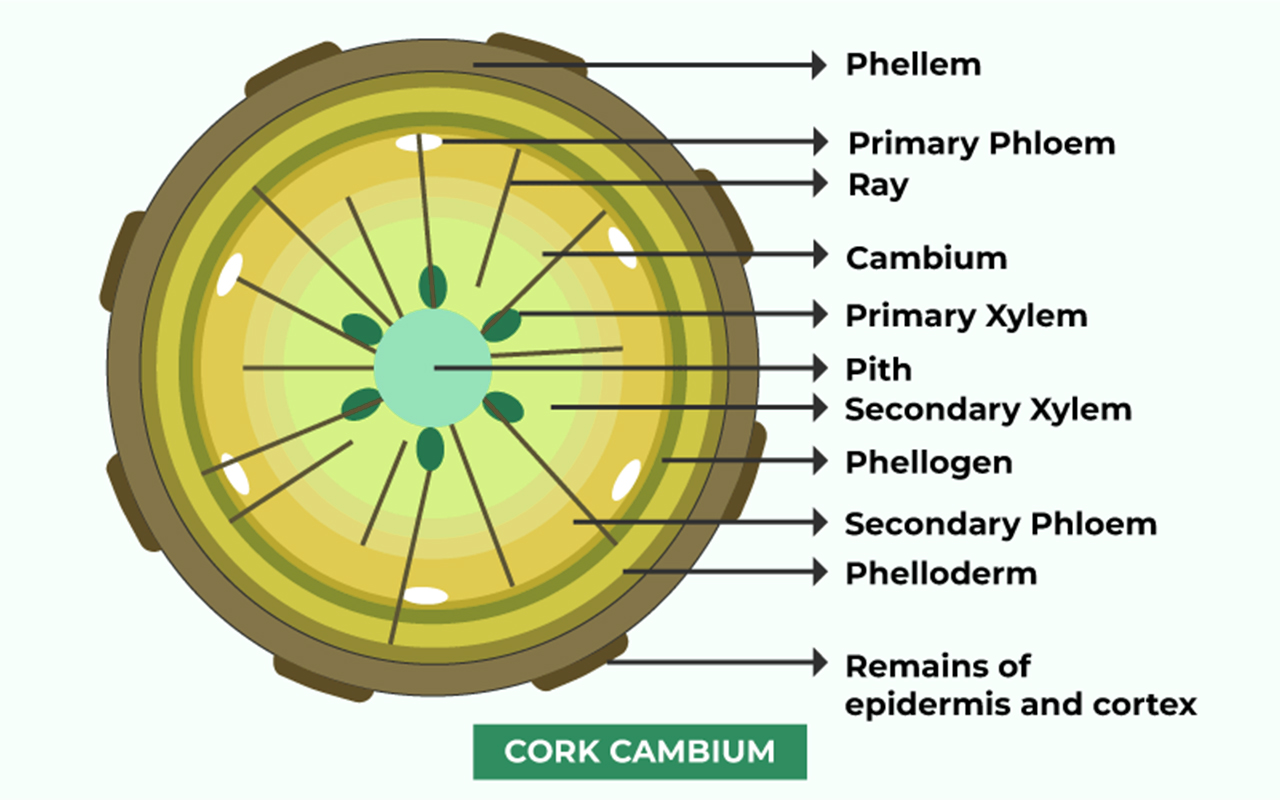
Cork Cambium: As the stem thickens due to the vascular cambium, the outer layers of the cortex and epidermis break down and need to be replaced to maintain protection. This leads to the formation of cork cambium (or phellogen) in the outer cortical area.
Cork cambium consists of compact, almost rectangular cells with thin walls. It produces cork cells (phellem) on the outside and phelloderm (secondary cortex) on the inside. The cork cells are impermeable to water due to suberin in their walls, while the phelloderm cells are more flexible. As the cork cambium continues to produce new cells, it causes the outer layers to become compressed, eventually causing them to die and peel off. In everyday language, the term "bark" refers to all tissues outside the vascular system, including the periderm (which consists of cork cambium, cork, and phelloderm) and the secondary phloem. Students can read the NEET biology notes on cork cambium including its structure and function, in the article below.Also Check:
Cork Cambium Meaning
Cork cambium is a type of plant tissue that forms part of the plant's outer covering, known as the periderm. This tissue consists of a single layer of cells responsible for producing cork cells and phelloderm cells. It is located in the stems and trunks of woody plants, such as angiosperms and gymnosperms.Cork Cambium Phellogen
Cork cambium, also known as phellogen, is a type of lateral meristem found in the stems and roots of many vascular plants. It plays an essential role in the formation of secondary tissues, contributing to the plant's growth and protectionAlso Check:
Cork Cambium Structure
The cork cambium, also known as phellogen, is a type of meristematic tissue present in many woody plants. It is located in the outer layer of the stem or trunk and is part of the periderm , which includes three layers:- Phelloderm: This layer is found inside the cork cambium and consists of living parenchyma cells.
- Phellogen (Cork Cambium): The cork cambium itself is a lateral meristem that facilitates secondary growth, replacing the epidermis in roots and stems. It produces cork cells, which help form the protective outer layers.
- Phellem (Cork): The outermost layer, made up of dead cells when mature. The appearance of cork varies among species and can include smooth, fissured, tessellated, scaly, or flaking textures.

| NEET Biology Notes | |||
|---|---|---|---|
| Embryo | Funaria | Selaginella | Malvaceae |
| Polyembryony | Apomixis | Pinus | Pollen Grains |
| Chara | Volvox | Endosperm | Equisetum |
Cork Cambium Function
The cork cambium performs several important functions:- Production of Cork and Secondary Cortex : It generates cork, a strong protective layer, and secondary cortex tissue.
- Secondary Growth : It is responsible for secondary growth in roots and stems, replacing the epidermis.
- Role as a Meristem : The cork cambium is a type of meristem, which is a tissue composed of embryonic cells that facilitate plant growth.
- Protection Against Disease : It helps protect the plant from fungal and bacterial infections.
- Water Retention : It prevents water loss through the bark.
- Periderm Tissue Production : The cork cambium produces periderm tissue, which includes cork and other protective layers.
| NEET Biology Notes | ||
|---|---|---|
| Plasma Membrane Structure | Pre-Fertilisation | Economic Importance of Algae |
| Slime moulds | hypotonic solution | Post fertilisation |
Cork Cambium Examples
The cork cambium is a type of plant tissue responsible for producing cork, which forms part of the outer bark. Examples include:- Oak Trees (Quercus spp.): Produces rugged bark.
- Pine Trees (Pinus spp.): Forms thick, protective bark.
- Cork Oak (Quercus suber): Harvested for its cork, a renewable resource.
- Birch Trees (Betula spp.): Produces distinctive, peeling white bark.
- Rubber Trees (Hevea brasiliensis): Contributes to the bark, important for latex production.
Cork Cambium Importance
Cork cambium, also known as phellogen, is a significant tissue layer found in the bark of woody plants. It plays a crucial role in the secondary growth of stems and roots, particularly in dicotyledonous plants. Here are the key points outlining the importance of cork cambium:- Production of Cork Cells : The primary function of cork cambium is to produce cork cells outwardly and phelloderm cells inwardly. Cork cells are dead at maturity and contain suberin, a waterproof substance that makes them impermeable to gases and water. This helps in protecting the plant from desiccation, mechanical injury, and pathogens.
- Bark Formation : Together with the secondary phloem (inner bark) and the cork cells it produces, cork cambium forms the bark of the plant. Bark serves as a protective layer that shields the plant from physical damage, herbivores, and pathogens. It also helps regulate water loss and gas exchange.
- Adaptation to Environment : Cork cambium allows plants to adapt to various environmental conditions, particularly in harsh climates where protection against extreme temperatures, UV radiation, and water loss is crucial. The thickened cork layers formed by the activity of cork cambium provide insulation and protection.
- Secondary Growth : Unlike primary growth, which involves the elongation of plant parts, secondary growth leads to an increase in girth. Cork cambium, along with vascular cambium, contributes to this radial growth by producing additional layers of tissues outwardly and inwardly.
- Commercial and Economic Importance : Cork cambium is of significant economic value in industries such as cork production. Cork obtained from the bark of the cork oak (Quercus suber) is widely used for manufacturing bottle stoppers, flooring, and insulation materials due to its unique properties.
- Healing Wounds : When the plant undergoes injury or damage, cork cambium plays a role in wound healing. It produces new cork cells to seal off wounds, preventing pathogens from entering and causing infections. This process is essential for the plant's survival and health.
Cork Cambium vs Vascular Cambium
The following tables provide difference between cork cambium and vascular cambium:| Cork Cambium vs Vascular Cambium | ||
|---|---|---|
| Feature | Cork Cambium | Vascular Cambium |
| Development Origin | Develops from the secondary lateral meristem. | Develops from the apical meristem. |
| Products | Gives rise to the bark and the secondary cortex. | Gives rise to the secondary xylem and phloem. |
| Location | Located outside the vascular tissues. | Located between the primary xylem and primary phloem. |
| Special Structures | Produces lenticels. | Produces the medullary rays. |
| Function | Provides protection against physical damage and prevents water loss. | Produces vascular tissue for plant conduction and structural support. |
| NEET Biology Notes | |||
|---|---|---|---|
| Rhizopus | Fibrous root | Marchantia | Actinomycetes |
| Nostoc | Spirogyra | Ribosomes | Liverworts |
Cork Cambium FAQs
Q 1. What is cork cambium and its function?
Ans. Cork cambium, also known as phellogen, is a lateral meristem found in the epidermis of many vascular plants. It plays a crucial role in secondary growth by producing cork cells that replace the epidermis in roots and stems. This process helps in increasing the girth and protection of the plant.
Q 2. What is another name for cork cambium?
Ans. Cork cambium is alternatively referred to as phellogen. It develops in the cortex region and contributes to the formation of cork cells due to cambial ring activity, which compresses outer layers like cortex cells and the epidermis.
Q 3. What is the function of cork?
Ans. Cork serves to protect plants by providing a cushion against physical and mechanical damage. Rich in suberin, a waxy substance, cork also acts as a barrier that minimizes water loss and enhances resistance against bacterial and fungal infections.
Q 4. Is cork cambium primary?
Ans. Cork cambium is a lateral meristem responsible for secondary growth in plants. It replaces the epidermis in roots and stems as part of the secondary growth process.
Q 5. Is cork xylem or phloem?
Ans. Cork cambium is neither xylem nor phloem. It is a type of lateral meristem that produces cork cells, which contribute to the outer bark of woody plants, protecting them and providing structural support.
Talk to a counsellorHave doubts? Our support team will be happy to assist you!

Free Learning Resources
PW Books
Notes (Class 10-12)
PW Study Materials
Notes (Class 6-9)
Ncert Solutions
Govt Exams
Class 6th to 12th Online Courses
Govt Job Exams Courses
UPSC Coaching
Defence Exam Coaching
Gate Exam Coaching
Other Exams
Know about Physics Wallah
Physics Wallah is an Indian edtech platform that provides accessible & comprehensive learning experiences to students from Class 6th to postgraduate level. We also provide extensive NCERT solutions, sample paper, NEET, JEE Mains, BITSAT previous year papers & more such resources to students. Physics Wallah also caters to over 3.5 million registered students and over 78 lakh+ Youtube subscribers with 4.8 rating on its app.
We Stand Out because
We provide students with intensive courses with India’s qualified & experienced faculties & mentors. PW strives to make the learning experience comprehensive and accessible for students of all sections of society. We believe in empowering every single student who couldn't dream of a good career in engineering and medical field earlier.
Our Key Focus Areas
Physics Wallah's main focus is to make the learning experience as economical as possible for all students. With our affordable courses like Lakshya, Udaan and Arjuna and many others, we have been able to provide a platform for lakhs of aspirants. From providing Chemistry, Maths, Physics formula to giving e-books of eminent authors like RD Sharma, RS Aggarwal and Lakhmir Singh, PW focuses on every single student's need for preparation.
What Makes Us Different
Physics Wallah strives to develop a comprehensive pedagogical structure for students, where they get a state-of-the-art learning experience with study material and resources. Apart from catering students preparing for JEE Mains and NEET, PW also provides study material for each state board like Uttar Pradesh, Bihar, and others
Copyright © 2025 Physicswallah Limited All rights reserved.
Get App









